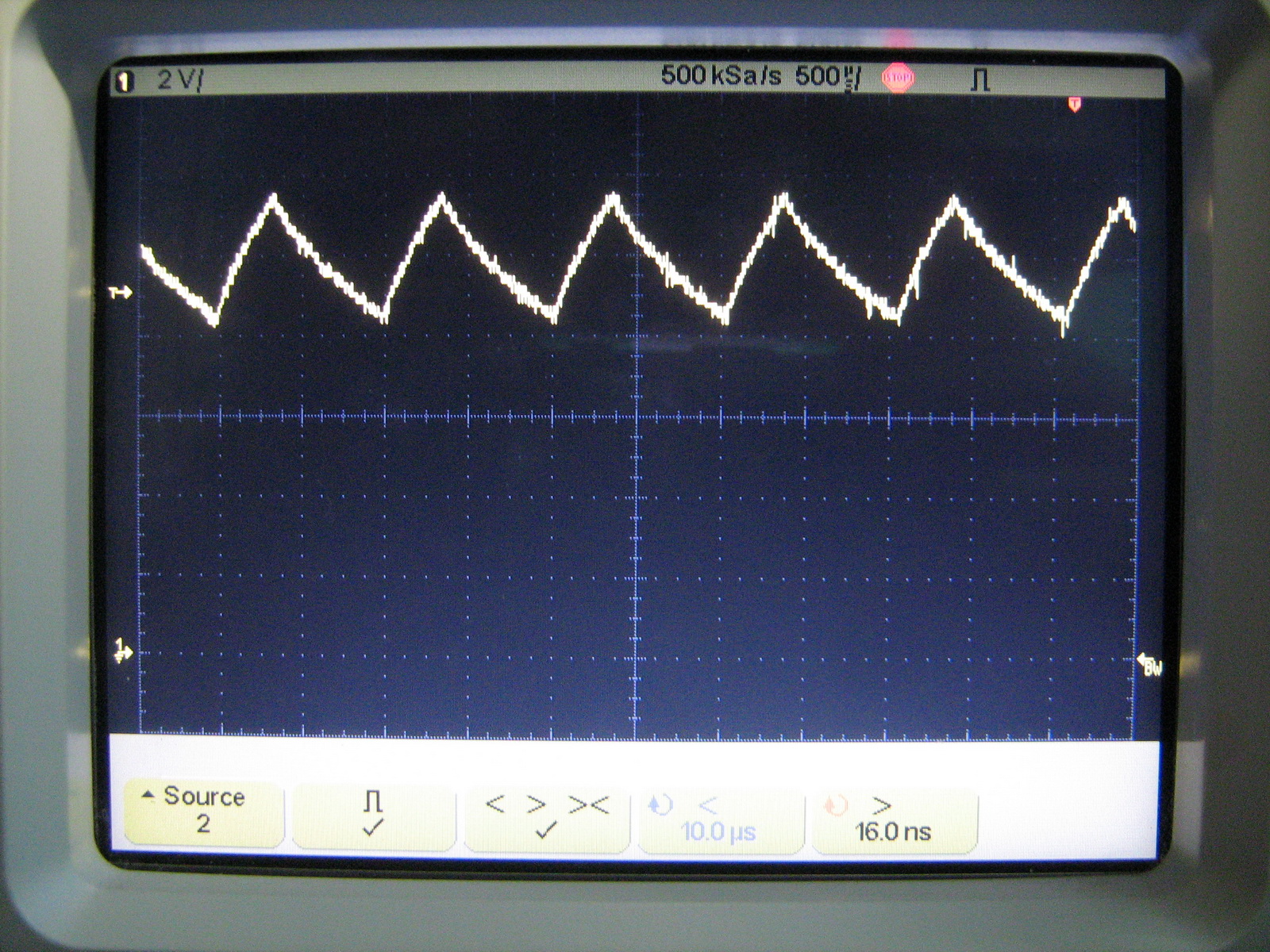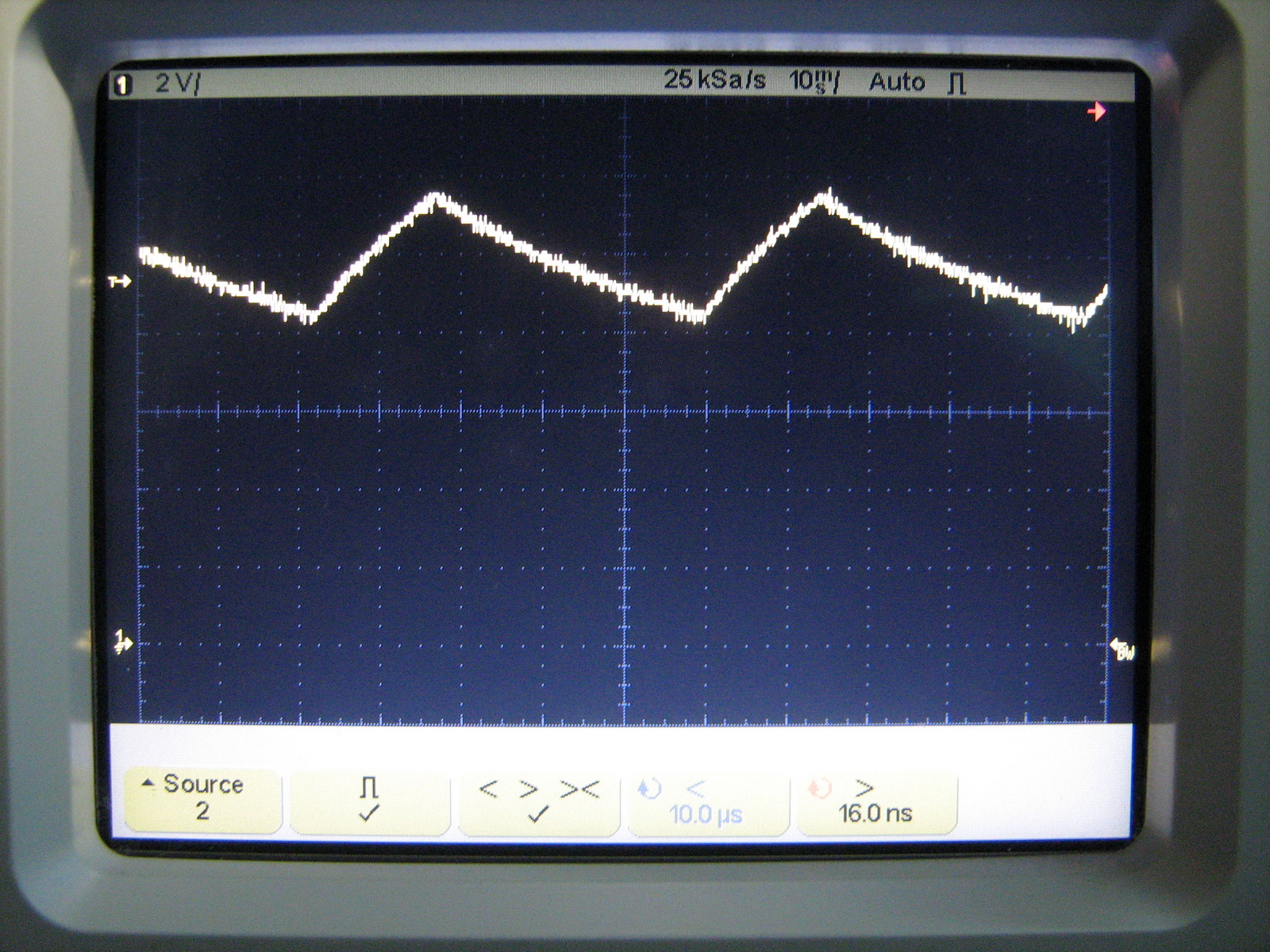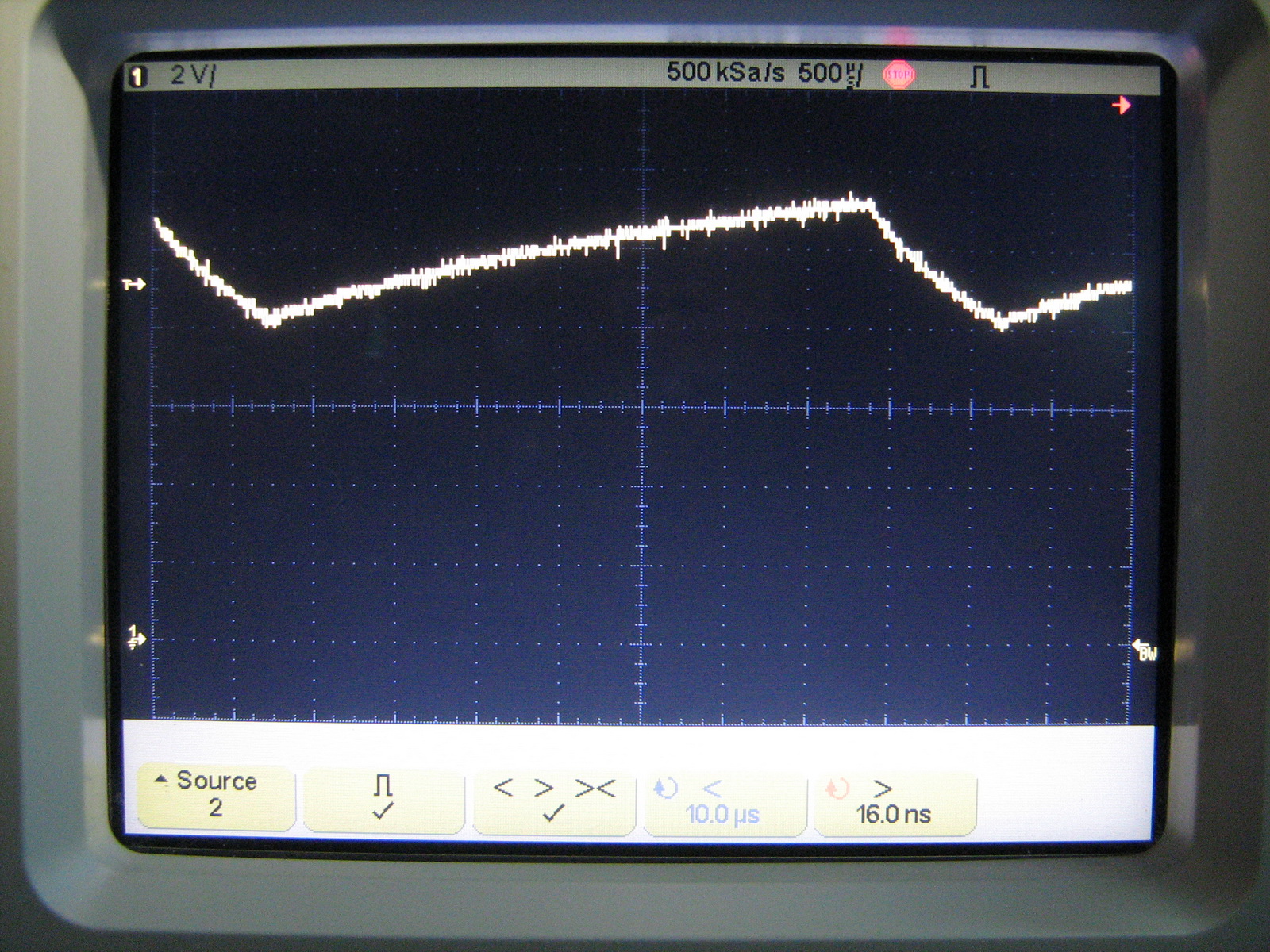| |
555 LED Pulsing Breathing Circuit |
|
Here is a circuit for simulating breathing / pulsing LED with the 555 timer chip. It became very popular and i received many comments and emails with people that made this circuit and worked fine, as well as comments with people that had troubles converting it to operate at 12 volts supply. It was designed to operate with 5 volts, because i plan to use it for a future PC mod. Since the PC power supply has 5 volts output, and since the LEDs that i plan to use require 3.8 volts to operate, choosing 5 volts for supply was the best choice to minimize power dissipation on the transistor.

Converting the original circuit to operate at 12 volts is not a big deal, but it requires some transistor knowledge. The only parts that should be changed were the biasing resistors R4 and R5. But i decided to take it one step further. I decided to make a more flexible breathing circuit. The new version as 2 more functions: It has an adjustable voltage oscillation amplitude, and an adjustable output DC offset. What this means is that it can be easily adjusted to operate with different LEDs. If for example the load is a 12V LED strip with operating voltage range 8 to 12 volts, the circuit can be adjusted to provide exactly this: 8 to 12 volts output. Similarly, it can be adjusted to operate with a high brightness LED that has voltage range from 2.4 to 3.8 volts.
The Circuit Here is the schematic circuit for the new version.
You can set the fade-in and fade-out durations with these potentiometers
You can set the output voltage amplitude and the output DC offset with these potentiometers.
You may need to add a heatsink to the power transistor.
As you may notice, the left portion of the circuit, the 555 astable multivariate - has not been changed. The functionality is exactly the same as described in the previous article. The two variable resistors R2 and R3 are used to set the fade-in and fade out time.
From the same position (across C1) i get the capacitor's voltage. This is the waveform that we will work with. I like the charging characteristic of the capacitor because it provides a more "natural" breathing effect. Instead, you may wanna use a triangular waveform as an input, but I've test it already and rejected it immediately.
Instead of using a diode to couple the 2 circuit parts, i use a large electrolytic capacitor. That is because i want to have a pure AC waveform to feed the first transistor amplifier. So, C2 is a coupling capacitor which cuts-off all DC currents form the 555 timer. A large resistor (R4) is used to minimize the effect of the transistor amplifier to the 555 operation.
The potentiometer R7 is the first new feature added to the circuit. This is the amplitude control potentiometer. This potentiometer changes the voltage amplitude that will be fed into the base of the transistor amplifier, and thus it controls the output signal amplitude. It works exactly as the volume control on an audio amplifier: the bigger the input signal, the bigger the output signal.
The first amplifier (T1) is a common emitter with fixed bias. R8 is the base resistor which sets the operation point, and R5 is the collector resistor which sets the amplification gain. The output of the amplifier is again coupled though a large electrolytic capacitor (C3). At the output of this coupling capacitor we have an AC signal oscillating around gnd, with the final amplitude that will be fed into the base of the second amplifier. Since the LEDs operate with voltages above 0V, we need to shift this oscillation to the proper position.
Suppose for example that we want to power an LED that operates from 2.4 to 3.8 volts. This means that the output oscillation amplitude should be 1.4 volts (3.3-2.4). At the output of C3 we will have an oscillation from -0.7 to +0.7 volts. So we need to shift this oscillation 3.1 volts. This is achieved by adding a DC offset. The potentiometer R6 does exactly this. It is connected as a voltage divider, and provides a DC voltage from 0 to 12 volts. This voltage is then injected at the AC voltage. The result is the required oscillation.
Finally, the signal is fed into an emitter follower amplifier (T2) to increase the current. I chose a power darlington pair transistor for this stage, so that it can provide sufficient current for the LEDs, and also to be able to dissipate enough power.
There is something that you should notice here: An emitter follower amplifier can provide maximum current, but the maximum voltage will be about 0.7 volts less than the supply voltage. What this means is that, if you plan to control a 12V LED strip (this is what most people told me that want to use), you will need at least 12.7 volts as supply to have full brightness.
ONE LAST THING!!! BE CAREFUL! As you see, i have no limiting resistor for the LEDs. You need to add a limiting resistor if required, otherwise bot the LEDs and the transistor may be damaged. I chose not to add a resistor, since the circuit can provide exactly the voltage required for the LEDs. If you set the circuit correctly, then you do not need to add any resistor. This is one good advantaged if you plan to use high power LEDs, since a high power LED would require a high wattage resistor. But make sure that you have set the circuit properly before connecting your expensive LED!
Adjusting the circuit It is very important to correctly adjust the circuit before you connect the LED. The adjustment has to do with the output voltage amplitude and DC offset. The maximum voltage of the oscillation must NOT exceed the maximum forward voltage (Vf) of the LED. As for the minimum oscillation voltage, this can be adjusted to any value.
If the LED forward voltage is the same as the circuit's supply then you can adjust the circuit more freely. But if the supply is much higher than the LED's voltage, you must follow these steps. First, you need to have a volt meter. It will be easier if the voltmeter has analog display.
Step 1:
Connect the voltmeter at the output of the circuit (pads LED+ and LED-).
Step 2:
Adjust the 555 to maximum fade-in and fade out duration, by turning the potentiometers R2 and R3 to maximum resistance
Step 3:
Turn the potentiometers R6 and R7 to the middle. The volt meter must now show readings. Notice that the readings are not stable, the voltage must increase and decrease slowly.
Step 4:
Now you need to decide what will be the voltage oscillation. You may wanna start with a typical 2 volts oscillation for a simple 3.2 or 3.8 Volts LED, or 4 volts oscillation for a 12 Volts LED strip. Turn the potentiometer R7 to adjust this oscillation. The maximum voltage shown on your volt-meter minus the minimum voltage is the oscillation amplitude. So, if for example you want to have 4 volts oscillation and the minimum voltage shown on the voltmeter is 4 volts, then turn the R7 slowly until the maximum voltage becomes 8 volts (8-4=4).
Step 5:
Now you need to adjust the DC offset. Slowly turn the potentiometer R6 until the maximum voltage of the oscillation becomes equal to the forward voltage of the LED. Do not rush finishing this step. Watch the multimeter for one minute or so and make sure that the voltage does NOT exceed the forward voltage of the LED.
If you finish all the previous steps successfully, you can connect the LED. Since the transistor has an internal collector resistance, you may wanna repeat step 5. That is because if the LED draws too much current, there will be a high voltage drop across VCE.
This is the output when the circuit operates as a flasher The fade-in is faster than the fade out The fade in is much slower than the fade out.
No DC offset added - The oscillation is around the zero line. Added 4 volts DC offset - The oscillation is from 2 to 6 Volts The amplitude is decreased. It is less than 2 volts The amplitude is increased. It is about 11 volts
Bill Of Materials [BOM]
Resistors
R1 Resistor 100 Ohm 1/4 Watt 5% Carbon Film [View photo]
R2 Potentiometer 10 KOhm Linear Rotary 1/2W
R3 Potentiometer 10 KOhm Linear Rotary 1/2W
R4 Resistor 82 KOhm 1/4 Watt 5% Carbon Film
R5 Resistor 1 KOhm 1/4 Watt 5% Carbon Film [View photo]
R6 Potentiometer 100 KOhm Linear Rotary 1/2W
R7 Potentiometer 470 KOhm Linear Rotary 1/2W
R8 Resistor 470 KOhm 1/4 Watt 5% Carbon Film
R9 Resistor 1 KOhm 1/4 Watt 5% Carbon Film [View photo]
R10 Resistor 100 KOhm 1/4 Watt 5% Carbon Film [View photo]
Capacitors
C1 Electrolytic Capacitor 470 uF 16 Volts
C2 Electrolytic Capacitor 470 uF 16 Volts
C3 Electrolytic Capacitor 470 uF 16 Volts
Diodes
D1 1N4148 Switching Diode [Switching diode]
Transistors
T1 BC338 NPN Silicon AF Transistors [NPN Silicon AF Transistors]
T2 TIP142 Complementary Silicon Power Darlington Transistor [Complementary Silicon Power Darlington Transistor]
Integrated Circuits
IC1 555 Timer



Related Links
Downloads
555 LED Pulsing Breathing Circuit - Link
|
|
|
| |
Accurate LC Meter
Build your own Accurate LC Meter (Capacitance Inductance Meter) and start making your own coils and inductors. This LC Meter allows to measure incredibly small inductances making it perfect tool for making all types of RF coils and inductors. LC Meter can measure inductances starting from 10nH - 1000nH, 1uH - 1000uH, 1mH - 100mH and capacitances from 0.1pF up to 900nF. The circuit includes an auto ranging as well as reset switch and produces very accurate and stable readings. |
|
PIC Volt Ampere Meter
Volt Ampere Meter measures voltage of 0-70V or 0-500V with 100mV resolution and current consumption 0-10A or more with 10mA resolution. The meter is a perfect addition to any power supply, battery chargers and other electronic projects where voltage and current must be monitored. The meter uses PIC16F876A microcontroller with 16x2 backlighted LCD. |
|
|
|
60MHz Frequency Meter / Counter
Frequency Meter / Counter measures frequency from 10Hz to 60MHz with 10Hz resolution. It is a very useful bench test equipment for testing and finding out the frequency of various devices with unknown frequency such as oscillators, radio receivers, transmitters, function generators, crystals, etc. |
|
1Hz - 2MHz XR2206 Function Generator
1Hz - 2MHz XR2206 Function Generator produces high quality sine, square and triangle waveforms of high-stability and accuracy. The output waveforms can be both amplitude and frequency modulated. Output of 1Hz - 2MHz XR2206 Function Generator can be connected directly to 60MHz Counter for setting precise frequency output. |
|
|
|
BA1404 HI-FI Stereo FM Transmitter
Be "On Air" with your own radio station! BA1404 HI-FI Stereo FM Transmitter broadcasts high quality stereo signal in 88MHz - 108MHz FM band. It can be connected to any type of stereo audio source such as iPod, Computer, Laptop, CD Player, Walkman, Television, Satellite Receiver, Tape Deck or other stereo system to transmit stereo sound with excellent clarity throughout your home, office, yard or camp ground. |
|
USB IO Board
USB IO Board is a tiny spectacular little development board / parallel port replacement featuring PIC18F2455/PIC18F2550 microcontroller. USB IO Board is compatible with Windows / Mac OSX / Linux computers. When attached to Windows IO board will show up as RS232 COM port. You can control 16 individual microcontroller I/O pins by sending simple serial commands. USB IO Board is self-powered by USB port and can provide up to 500mA for electronic projects. USB IO Board is breadboard compatible. |
|
|
|
|
ESR Meter / Capacitance / Inductance / Transistor Tester Kit
ESR Meter kit is an amazing multimeter that measures ESR values, capacitance (100pF - 20,000uF), inductance, resistance (0.1 Ohm - 20 MOhm), tests many different types of transistors such as NPN, PNP, FETs, MOSFETs, Thyristors, SCRs, Triacs and many types of diodes. It also analyzes transistor's characteristics such as voltage and gain. It is an irreplaceable tool for troubleshooting and repairing electronic equipment by determining performance and health of electrolytic capacitors. Unlike other ESR Meters that only measure ESR value this one measures capacitor's ESR value as well as its capacitance all at the same time. |
|
Audiophile Headphone Amplifier Kit
Audiophile headphone amplifier kit includes high quality audio grade components such as Burr Brown OPA2134 opamp, ALPS volume control potentiometer, Ti TLE2426 rail splitter, Ultra-Low ESR 220uF/25V Panasonic FM filtering capacitors, High quality WIMA input and decoupling capacitors and Vishay Dale resistors. 8-DIP machined IC socket allows to swap OPA2134 with many other dual opamp chips such as OPA2132, OPA2227, OPA2228, dual OPA132, OPA627, etc. Headphone amplifier is small enough to fit in Altoids tin box, and thanks to low power consumption may be supplied from a single 9V battery. |
|
|
|
|
|
Arduino Prototype Kit
Arduino Prototype is a spectacular development board fully compatible with Arduino Pro. It's breadboard compatible so it can be plugged into a breadboard for quick prototyping, and it has VCC & GND power pins available on both sides of PCB. It's small, power efficient, yet customizable through onboard 2 x 7 perfboard that can be used for connecting various sensors and connectors. Arduino Prototype uses all standard through-hole components for easy construction, two of which are hidden underneath IC socket. Board features 28-PIN DIP IC socket, user replaceable ATmega328 microcontroller flashed with Arduino bootloader, 16MHz crystal resonator and a reset switch. It has 14 digital input/output pins (0-13) of which 6 can be used as PWM outputs and 6 analog inputs (A0-A5). Arduino sketches are uploaded through any USB-Serial adapter connected to 6-PIN ICSP female header. Board is supplied by 2-5V voltage and may be powered by a battery such as Lithium Ion cell, two AA cells, external power supply or USB power adapter. |
|
200m 4-Channel 433MHz Wireless RF Remote Control
Having the ability to control various appliances inside or outside of your house wirelessly is a huge convenience, and can make your life much easier and fun. RF remote control provides long range of up to 200m / 650ft and can find many uses for controlling different devices, and it works even through the walls. You can control lights, fans, AC system, computer, printer, amplifier, robots, garage door, security systems, motor-driven curtains, motorized window blinds, door locks, sprinklers, motorized projection screens and anything else you can think of. |
|
|
|